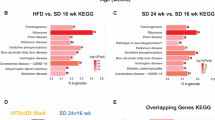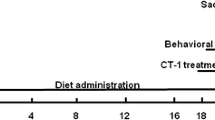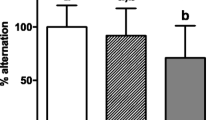Abstract
background
Inhibition of hippocampal CREB signaling contributed to obesity-induced cognitive impairment. But, the potential mechanism by which obesity inhibits hippocampal CREB signaling is not clear. The aim of this study was to explore whether interleukin-2 played a intermediary role in this pathogenic effect in a high-fat diet model.
Methods
C57BL/6J interleukin-2+/+ wild-type and interleukin-2−/− knockout mice were fed a standard diet or high-fat diet for 12 weeks. After that, cognitive function was assessed by Morris water maze and Y maze. Depression-like behaviors were determined using sucrose preference test and tail suspension test. Expression of p-CREB and interleukin-2 in peripheral blood mononuclear cells and hippocampus was measured using western blotting and qRT-PCR.
Results
In the interleukin-2+/+ wild-type mice, a high-fat diet inhibited the expression of interleukin-2 and p-CREB both in the peripheral blood mononuclear cells and hippocampus. The high-fat diet also caused cognitive impairment and depression-like behaviors in these mice. In the interleukin-2−/− knockout mice, there was no significant depression of interleukin-2. A high-fat diet can only aggravate the p-CREB signaling dysfunction in the peripheral blood mononuclear cells, but not in the hippocampus. Meanwhile, the high-fat diet can not cause the cognitive impairment and depression-like behaviors in these mice.
Conclusions
A high-fat diet induced hippocampal CREB dysfunction, cognitive impairment and depression-like behaviors partly through downregulation of interleukin-2 in the mice.







Similar content being viewed by others
Availability of data and material
The data can not be shared because this is an ongoing study.
Code Availability
All analysis was performed by Statistical Product and Service Solutions 26.0.
References
Alves S, Churlaud G, Audrain M et al (2017) Interleukin-2 improves amyloid pathology, synaptic failure and memory in Alzheimer’s disease mice. Brain 140:826–842
Bartfai T, Schultzberg M (1993) Cytokines in neuronal cell types. Neurochem Int 22:435–444
Bostik P, Noble ES, Stephenson ST et al (2007) CD4 + T cells from simian immunodeficiency virus disease-resistant sooty mangabeys produce more IL-2 than cells from disease-susceptible species: involvement of p300 and CREB at the proximal IL-2 promoter in IL-2 up-regulation. J Immunol 178:7720–7729
Felger JC, Cole SW, Pace TW et al (2012) Molecular signatures of peripheral blood mononuclear cells during chronic interferon-alpha treatment: relationship with depression and fatigue. Psychol Med 42:1591–1603
Flescher E, Fingrut O (2000) Cytokine. Suppression of interleukin 2 biosynthesis by three modes of oxidative cellular stress: selective prevention by N-acetyl cysteine. Cytokine 12:495–498
Furukawa S, Fujita T, Shimabukuro M et al (2004) Increased oxidative stress in obesity and its impact on metabolic syndrome. J Clin Invest 114:1752–1761
Ghosh A, Gao L, Thakur A et al (2017) Role of free fatty acids in endothelial dysfunction. J Biomed Sci 24:50
Guyot DJ, Newbound GC, Lairmore MD (1998) Co-stimulation of human peripheral blood mononuclear cells with IL-2 and anti-CD3 monoclonal antibodies induces phosphorylation of CREB. Immunol Lett 61:45–52
Kalkhoven E (2004) CBP and p300: HATs for different occasions. Biochem Pharmacol 68:1145–1155
Karczewski J, Śledzińska E, Baturo A et al (2018) Obesity and inflammation. Eur Cytokine Netw 29:83–94
Kaur SS, Gonzales MM, Eagan DE et al (2015) Inflammation as a mediator of the relationship between cortical thickness and metabolic syndrome. Brain Imaging Behav 9:737–743
Kishi E, Takahashi A, Ishimaru H et al (2001) Development of obesity and neurochemical backing in aurothioglucose-treated mice. Auton Neurosci 92:21–27
Malek TR (2008) The biology of interleukin-2. Annu Rev Immunol 26:453–479)
Moore A, Beidler J, Hong MY (2018) Resveratrol and Depression in Animal Models: A Systematic Review of the Biological Mechanisms. Molecules 23:2197
Mulder GB, Pritchett K (2003) The Morris water maze. Contemp Top Lab Anim Sci 42:49–50
Nestler EJ, Barrot M, DiLeone RJ et al (2002) Neurobiology of depression. Neuron 34:13–25
Orozco Valencia A, Camargo Knirsch M, Suavinho Ferro E et al (2020) Interleukin-2 as immunotherapeutic in the autoimmune diseases. Int Immunopharmacol 81:106296
Petitto JM, Cushman JD, Huang Z (2015) Effects of Brain-Derived IL-2 Deficiency and the Development of Autoimmunity on Spatial Learning and Fear Conditioning. J Neurol Disord 3:196
Pol JG, Caudana P, Paillet J et al (2020) Effects of interleukin-2 in immunostimulation and immunosuppression. J Exp Med 217:e20191247
Raker VK, Becker C, Steinbrink K (2016) The cAMP Pathway as Therapeutic Target in Autoimmune and Inflammatory Diseases. Front Immunol 7:123
Sasaki-Hamada S, Hojyo Y, Mizumoto R et al (2021) Cognitive and hippocampal synaptic profiles in monosodium glutamate-induced obese mice. Neurosci Res 170:201–207
Sheldon J (1970) Obesity: some current views regarding its aetiology. Postgrad Med J 46:613–617
Silva AJ, Kogan JH, Frankland PW et al (1998) CREB and memory. Annu Rev Neurosci 21:127–148)
Smith KA (1992) Interleukin-2. Curr Opin Immunol 4:271–276
Song YS, Lee YS, Narasimhan P et al (2007) Reduced oxidative stress promotes NF-kappaB-mediated neuroprotective gene expression after transient focal cerebral ischemia: lymphocytotrophic cytokines and antiapoptotic factors. J Cereb Blood Flow Metab 27:764–775)
Vargas R, Ryder E, Diez-Ewald M et al (2016) Increased C-reactive protein and decreased Interleukin-2 content in serum from obese individuals with or without insulin resistance: Associations with leukocyte count and insulin and adiponectin content. Diabetes Metab Syndr 10:S34–41
Wang F, Wang L, Wang Y et al (2020) Exogenous IGF-1 improves cognitive function in rats with high-fat diet consumption. J Mol Endocrinol 64:115–123
Yang C, Sui G, Li D et al (2021) Exogenous IGF-1 alleviates depression-like behavior and hippocampal mitochondrial dysfunction in high-fat diet mice. Physiol Behav 229:113236
Yoshizaki K, Asai M, Hara T (2020) High-Fat Diet Enhances Working Memory in the Y-Maze Test in Male C57BL/6J Mice with Less Anxiety in the Elevated Plus Maze Test. Nutrients 12:2036
Zhang S, Zhao M, Wang F et al (2020) Relationship between normal weight obesity and mild cognitive impairment is reflected in cognitive-related genes in human peripheral blood mononuclear cells. Psychogeriatrics 20:35–43
Acknowledgements
We wanted to thank Prof. Jia Qifen from TIANJIN UNIVERSITY (China) for the funding and laboratory support for this project.
Funding
Not applicable.
Author information
Authors and Affiliations
Contributions
Zheng Chen, Lu Wang and Feng Wang conducted the study design, literature research and manuscript preparation. Guanghong Sui and Caixia Yang carried out the experiment and performed the data analysis. Guanghong Sui was responsible for the revision of the article.
Corresponding authors
Ethics declarations
Conflict of interest
Not applicable.
Ethics approval
The study was approved by the ethics committees of Tianjin Anding Hospital.
Consent to participate
This was an animal study, and no human subjects were included.
Consent for publication
All authors agreed to submit this article to your journal.
Additional information
Publisher’s Note
Springer Nature remains neutral with regard to jurisdictional claims in published maps and institutional affiliations.
Rights and permissions
About this article
Cite this article
Chen, Z., Sui, G., Wang, L. et al. High-fat diet induced hippocampal CREB dysfunction, cognitive impairment and depression-like behaviors via downregulation of interleukin-2 in the mice. Metab Brain Dis 37, 1163–1174 (2022). https://doi.org/10.1007/s11011-022-00938-1
Received:
Accepted:
Published:
Issue Date:
DOI: https://doi.org/10.1007/s11011-022-00938-1




